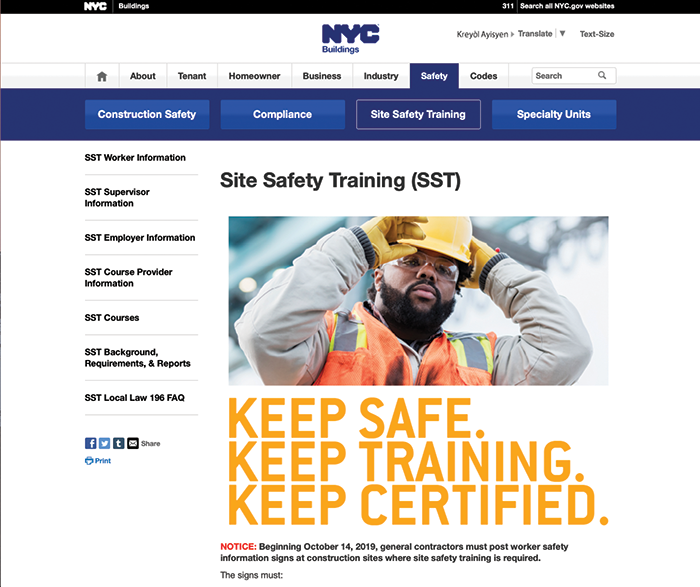New York City mandates on-site safety training reminderss

|
On Oct. 14, New York City Department of Buildings Commissioner Melanie E. La Rocca announced large complex construction sites in the city must begin posting at their exits multilingual notices about upcoming safety training requirements. The notices must include every language used by workers to communicate at each construction site.
As of Dec. 1, all workers at large construction sites in the city must have at least 30 hours of site-safety training, and supervisors must have at least 62 hours. A 40-hour training requirement for workers at large construction sites will take effect Sept. 1, 2020.
Additional signage requirements, downloadable notice templates in 14 languages and an interactive map to determine whether workers on specific construction sites are required to undergo the safety training are available at www1.nyc.gov/site/buildings/safety/sst-safety.page.
California governor enhances employee protections
 Newsom Newsom
|
On Oct. 10, Gov. Gavin Newsom (D-Calif.) signed three bills meant to expand workers’ rights.
Assembly Bill 51 prohibits employers from requiring workers or applicants to waive their rights under the California Fair Employment and Housing Act or other employment statutes as a condition of employment. It also prohibits conditioning employment-related benefits on workers waiving their rights.
Under Assembly Bill 9, workers have three years instead of one year to file a complaint alleging employment law violations—including workplace harassment and discrimination—with the Department of Fair Employment and Housing.
Assembly Bill 547, the third bill, requires janitorial employees to receive sexual violence and harassment training conducted by their peers every two years. Peer trainers must have at least 40 hours of training, have two years of nonsupervisory work in the janitorial industry and be fluent in the language most spoken by the other workers.
“Work is about more than earning an income,” Newsom said in a statement. “For many, a job can provide a sense of purpose and belonging—the satisfaction of knowing your labor provides value to the world. Everyone should have the ability to feel that pride in what they do, but for too many workers, they aren’t provided the dignity, respect or safety they deserve. These laws will help change that.”
OSHA implements new workplace inspection weighting system
On Oct. 1, the Occupational Safety and Health Administration implemented its OSHA Weighting System for fiscal year 2020. The new system encourages allocation of resources to support OSHA’s approach of promoting safe and healthy workplaces while continuing to develop and support a management system that focuses enforcement activities on critical and strategic areas where OSHA’s efforts can be most effective.
Under the previous enforcement weighting system initiated during fiscal year 2015, OSHA weighted certain inspections based on the time taken to complete an inspection or—in some cases—the inspection’s effects on workplace safety and health. The OSHA Weighting System is based on an evaluation of the existing criteria and a working group’s recommendations regarding improvements. The new system recognizes time is not the only factor to assess; factors such as types of hazards inspected and abated, as well as effective targeting, influence the effects on workplace safety and health.
The system will continue to weight inspections but will do so based on factors such as agency priorities and the effects of inspections. The new approach is meant to reinforce OSHA’s balanced approach to occupational safety and health and will incorporate the three major work elements performed by the field: enforcement activity, essential enforcement support functions (such as severe injury reporting and complaint resolution) and compliance assistance efforts.



